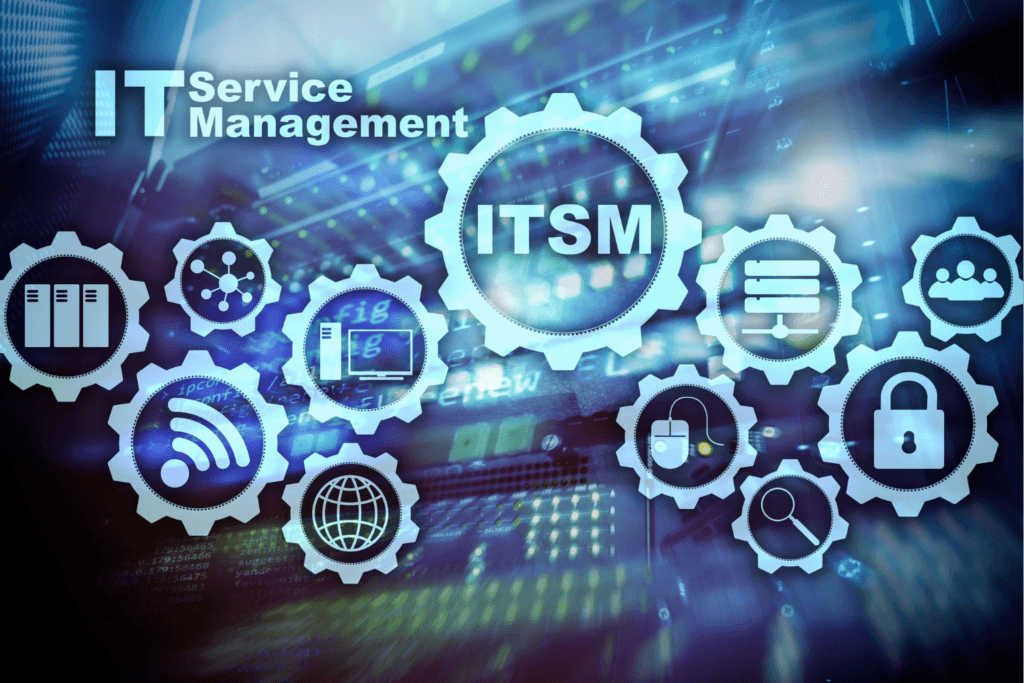IT service management (ITSM) has become a key element ensuring the smoothness and efficiency of business operations. It enables companies not only to quickly respond to IT incidents, but also to predict and prevent them, thanks to which the organization can focus on its strategic goals. In the article, we explain how ITSM tools and its methodologies can contribute to increasing the efficiency of IT service management.
In the face of constant technological evolution and growing customer expectations, IT service management is emerging as an essential foundation for every modern organization. Effective IT service management, supported by ITSM, enables companies to not only optimize their IT operations, but also provide higher quality services to their customers. In the context of a rapidly changing business environment, measuring the effectiveness of these activities using a precisely selected group of KPIs for ITSM is becoming a key element enabling continuous adaptation and improvement of IT processes in order to achieve the strategic goals of the organization.

What is IT Service Management and why is it so important?
IT service management is a discipline whose task is to ensure that all technological processes, human resources and company policies are organized in such a way that they can support business goals and operations. In a broad scope, IT service management concerns not only the management of IT incidents and problems, but also change management, configuration and the ability to continuously deliver value to the business through IT services.
The modern business world is becoming more and more dependent on technology. In such an environment, effective IT service management is essential to maintain business continuity, data security and customer satisfaction. It is IT service management that allows companies to quickly adapt to new market requirements, while ensuring operational stability and minimizing the risk of technological failures.
A key aspect of effective IT service management is the ability to predict and prevent problems before they impact business operations. By applying best practices and standards such as ITIL, organizations can structure IT processes to increase their efficiency and effectiveness. This, in turn, leads to better resource management, cost optimization and, most importantly, improved quality of services provided to end users.
The importance of IT service management grows with technological evolution and business needs. Organizations that effectively implement IT service management gain a strategic advantage, allowing not only more effective use of technological resources, but also dynamic development in response to changing market conditions. As a result, IT service management becomes a key element of the strategy of every company striving to achieve and maintain competitiveness on the market.
Key processes in IT Service Management
Within IT Service Management, there are several key processes that are the foundation for the effective management of IT services and supporting the continuity of business operations. These processes include:
- Incident management – quickly identify, analyze and resolve IT incidents to minimize their impact on business operations.
- Problem management – identifying the causes of IT incidents and eliminating them to prevent future failures.
- Change management – controlling and managing changes in IT infrastructure to minimize risk and disruption to business operations.
- Configuration management – maintaining the consistency of the IT system by controlling and managing the versions of configuration elements.
- Service Level Management – monitoring and managing IT service levels in accordance with SLAs (Service Level Agreements) to ensure optimal quality of services for users.
How does incident management impact the continuity of business operations?
Incident management is one of the most important processes within IT Service Management, which is crucial for maintaining the continuity of business operations. This process involves quickly identifying, recording and classifying IT incidents, and then allocating the resources necessary to quickly resolve them.
The goal of incident management is to restore normal operations as quickly as possible while minimizing the negative impact on the business and its customers. Effective incident management not only quickly resolves individual negative incidents, but also contributes to improving the overall quality of IT services by analyzing the causes and implementing long-term solutions to prevent similar problems in the future.
Through this process, organizations can reduce service downtime, which is crucial to ensuring business continuity and customer satisfaction.
ITSM tools – which ones to choose for your organization?
ITSM tools are an important issue, and choosing the right ones is a key element that can significantly affect the effectiveness of IT service management in any organization. There are many ITSM tools available on the market – each with different features, integration options and levels of personalization. To choose the most suitable ones, companies should consider several key factors:
- The size of the organization – some ITSM tools are better suited to large enterprises with complex IT needs, while others are ideal for smaller companies with simpler requirements.
- Budget – cost is always an important factor when choosing an ITSM tool. Not only should you consider the initial purchase cost, but also maintenance costs and potential fees for additional features or integrations.
- Specific business requirements – companies should identify their unique requirements and needs to select the ITSM tools that best meet them, such as incident management, problem management, change management and service level management.
How to assess which ITSM tools are the best for your company?
Assessing which ITSM tools are best for your company requires a thoughtful approach and often begins with a detailed analysis of your business and technical needs. Below are steps that can help you evaluate and select the most appropriate ITSM tools:
- Conduct an audit of existing IT processes and identify areas for improvement – understanding the current state of IT service management in your company is the first step to choosing the right tool.
- Define key requirements – determine what functionalities are necessary for your organization. This may include process automation, integration with existing systems, scalability or availability of technical support.
- Compare offers from different vendors – collect information about different ITSM tools and compare them in terms of functions, costs, integration possibilities and opinions of other users.
- Conduct pilot tests – select several ITSM tools that best suit your requirements and test them in a test environment. This will allow you to assess how these tools work in practice and how easy they are to implement and use.
- Take into account user opinions – taking into account the opinions and experiences of people who will use the ITSM tool on a daily basis may be crucial to the success of its implementation.
Choosing the right ITSM tool is a process that requires careful consideration of various factors. When making a decision, it is worth taking into account not only the current needs of the company, but also anticipating future requirements so that the selected tools support the development and scaling of the business.
Methodologies in ITSM: ITIL, Agile, DevOps
In the world of IT service management, ITSM methodologies play a key role in shaping the way organizations deliver and manage their IT services. The most famous and widely used ITSM methodologies are ITIL, Agile in ITSM and DevOps in IT management. Each of these methodologies brings a unique approach and set of practices that can be integrated to improve the efficiency, flexibility and quality of IT service delivery.
ITIL (Information Technology Infrastructure Library) is considered a standard in the field of ITSM methodology. It focuses on ensuring high quality IT services by defining a set of service management best practices. ITIL helps companies manage risk, strengthen customer relationships, establish cost-effective operating procedures, and build a stable IT environment that can evolve and adapt to changing business needs.
Agile in ITSM focuses on adaptability and continuous improvement of IT service management processes. Adopting agile practices in ITSM enables companies to respond more quickly to changes, both internal and external, and better align IT services with current business needs. Agile in ITSM promotes a culture of collaboration, knowledge sharing and continuous learning, which contributes to increased innovation and operational efficiency.
DevOps in IT management is an approach that focuses on improving collaboration between software development teams and IT operations. The main goal of DevOps is to increase the speed of delivery of software and IT services, while maintaining a high level of stability, security and quality. Integrating DevOps into IT management helps break down traditional communication and operational barriers, contributing to faster innovation and improved customer satisfaction.
How can ITSM methodologies fit with your company culture?
The introduction and integration of ITSM methodologies in a company requires not only understanding the technical aspects of these methodologies, but also adapting them to the organizational culture. The success of implementing ITIL, Agile in ITSM or DevOps in IT management depends on the commitment and readiness of all levels of the organization to adaptation and continuous improvement.
- ITIL can support a customer- and quality-focused culture by promoting the stability and reliability of IT services.
- Agile in ITSM fits perfectly into a dynamic and flexible work environment, encouraging innovation and continuous adaptation.
- DevOps in IT management can, in turn, strengthen collaboration and communication between different departments, promoting a culture of continuous improvement and rapid implementation of changes.
The key for every company is to select and adapt the ITSM methodology that best suits its unique needs, business goals and organizational culture. Such integration can significantly improve the quality and efficiency of IT service management, and thus contribute to the success of the entire enterprise.
How to measure the effectiveness of IT management?
Measuring the effectiveness of IT management is crucial for any company that wants not only to optimize its IT processes, but also to ensure that they bring real business value. Using appropriate KPIs for ITSM (key performance indicators) allows for an objective assessment of IT activities and their impact on the overall performance of the company. KPIs should be closely related to the organization’s business goals and enable monitoring of progress towards achieving them.
What KPIs are key in assessing ITSM effectiveness?
The selection of key KPIs for ITSM depends on the company’s specific business needs and goals. However, there are several metrics that are widely recognized as critical in assessing the effectiveness of IT service management:
- Incident resolution time – measures the average time it takes to resolve an IT incident. Less time means greater efficiency in incident management and faster restoration of normal operations.
- User satisfaction rate – an assessment of how end users perceive the quality of IT services, which can be measured through satisfaction surveys. High user satisfaction is an indicator that IT services are well managed and meet business expectations.
- Percentage of services delivered in accordance with SLAs – measures what percentage of IT services were delivered in accordance with established service levels (Service Level Agreements). This is a key indicator of whether quality and response goals are being met.
- Incident management cost – determines the average cost of resolving a single IT incident. This helps you understand the economic efficiency of incident management processes and identify areas where expenses can be reduced.
- Number of incidents caused by changes – measures how many IT incidents occurred as a result of introduced changes. A low ratio indicates the effectiveness of the change management process and the company’s ability to minimize the risk associated with modifications to the IT infrastructure.
Using these and other KPIs for ITSM allows IT managers to monitor performance, identify areas for improvement, and make appropriate decisions that support business goals. However, it is crucial that the selected indicators are constantly reviewed and adapted to the changing needs of the company.
How to implement ITSM in an organization step by step?
Implementing IT Service Management in a company is a process that requires thorough planning and commitment at many organizational levels. An appropriate approach to ITSM implementation can significantly contribute to improving the quality and effectiveness of IT services and, consequently, to increasing customer and end-user satisfaction. Here are the steps that will help you successfully implement ITSM in your company:
- Defining the goals and scope of the project – the first step is to clearly define what you want to achieve with the implementation of ITSM and define the scope of the project. The goal should be consistent with the company’s overall business strategy.
- Assessing the current situation – understanding the current state of IT processes and identifying areas requiring improvement is crucial for subsequent implementation success.
- Selecting appropriate tools and technologies – based on the defined goals and assessment, you should select ITSM tools that best meet the needs of the organization.
- Process design and planning – new or modified ITSM processes that will be introduced in the company should be designed, taking into account best practices and industry standards.
- Training and competence development – a key element is preparing the IT team to work with new processes and tools. Training and competence development are essential here.
- Implementation – after preparations, you move to the implementation phase, which should be carried out in stages to minimize risk and enable ongoing monitoring of progress.
- Monitoring and continuous improvement – after implementation, it is crucial to constantly monitor the effectiveness of new processes and make necessary adjustments to optimize them.
Completion of the ITSM implementation process does not mean the end of activities. On the contrary, it is the beginning of a continuous process of improving and adapting IT service management to the changing needs and expectations of the company and its customers. Successful ITSM implementation requires commitment, flexibility and a willingness to constantly learn and adapt.
Effective management of IT services, through the use of best ITSM practices and tools, is the foundation of modern companies, enabling them not only to optimize operations, but also to ensure business continuity and customer satisfaction. Methodologies such as ITIL, Agile and DevOps, combined with well-selected KPIs, enable not only measurement, but also continuous improvement of IT processes. Implementing ITSM is a journey that brings lasting benefits to the organization, its employees and customers, supporting dynamic development and adaptation to the changing business environment.



